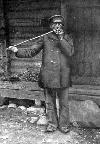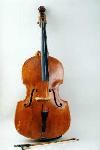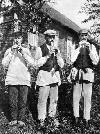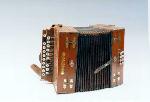INSTRUMENTAL MUSIC |
||||
WIND INSTRUMENTS (AEROPHONES) Aerophones make up the richest and most varied group of traditional Lithuanian instruments. They fall into three general categories: (1) whistles, including
skuduciai (linear flute type, several closed pipes); vilioklis, svilpukas, molinukas,
lamzdelis (linear flute type), and svilpa (transverse flute type); |
||||
Skuduciai are found only in a few parts of northeastern Lithuania (Vabalninko, Kupiskio, and Birzu Districts, Rokiskis and Panevezys Counties). The skuduciai are made of umbelliferous plants or wood. Shorter-lived skuduciai are made from various grass-like reeds. Sturdier forms are made of ash, black alder, alder, or willow wood. The wooden rods are cut into pieces of varied length. The number of whistles varies, but a typical set has five to eight. The whistles are hollowed out either by burning or carving, leaving the bottom closed. If the entire whistle is hollow, then the bottom is closed off with a fixed or movable stopper. Zieves skuduciai (made of bark) are also closed with a stopper. For skuduciai made of umbelliferous plants, the joints of the plants close off the bottom of the whistle. The open ends of each whistle are cut on both sides at a sloping angle. A single whistle produces only one note. There are two basic means of tuning the skuduciai: (1) the length of the shortest whistle is determined by ear. To it are added the second, third, fourth etc. skuduciai, tuned at intervals of a second. (2) whistles are tuned at intervals of a second, beginning with the longest whistle (which plays the lowest note). Skuduciai are played by pressing a whistle to the lower lip and blowing sharply, as if spitting. They are used to play instrumental sutartines, characterized by five-part figures of repeated, rhytmic, two-note combinations. Three types of sutartines are most popular: Untyte, Intakas and Kate. The skuduciai were played most commonly by men, but women and even children are also known to have played these rhythmic formulas. They were played outdoors while going to work or resting, at communal harvests (pabaigtuves) and work bees (talkos), during night grazing of horses (naktigone), on Saturday and Sunday evenings, and as entertainment at young peoples gatherings. Herding boys played skuduciai during the spring celebration of melstuves. Skuduciai: sutartinė, played by R.Kaminskaitė, I.Mataitytė, J.Turčinavičiūtė, RATILIO, 1982 - [audio] |
||||
Vilioklis, svilpukas, molinukas and lamzdelis belong to the linear flute type of instruments. Vilioklis is made of a bird wing bone or goose quill. A deep cavity is carved in one end of the instrument, with a sound hole near it. A fluttering, bird-like sound is produced by blowing into the hollow end and periodically covering the hole with a finger. The vilioklis is used by hunters to lure ducks and other birds. |
||||
Svilpukai are made in three ways: |
||||
|
molinukai |
Molinukai are made in the shape of a tube or a toy figure. The tube-shaped whistles are made of clay mixed with sand. The clay is kneaded and rolled, and rolled around a small stick. The stick is removed, one end of the tube is squeezed shut, while the other end is flattened and the blowing hole is made with a thin splinter. A whistle hole and two to four finger holes are made in the top. Toy shapes are made in the same way as tubes, but the hollow is carved in a finished shape. The molinukai are carved and then fired in an oven. The sound of a molinukas is soft, and the tembre is delicate. Musical possibilities are determined by the number of finger holes. Melodies are improvised. At times, sutartines were played with these whistles. The molinukai were toys used by herders and children. Molinukai: imitation of bird's voices, instrumental group, RATILIO, 1982 - [audio] |
|||
|
lamzdeliai |
Traditional lamzdeliai (pipes) are made of either bark or wood. The bark pipe (zieves lamzdelis) is made in the springtime of a willow, aspen or pine sprout. The bark is beaten on all sides, and twisted off of the wood. The blowing end is closed off with a stopper made from the wood, with one side cut off. At the place where the stopper ends, a whistle hole is cut into the bark, and one end of the hole is bent slightly inwards. Three to six finger holes are cut in the pipe. Wooden pipes are made of ash or linden wood. The bark is removed, and the instrument is hollowed out by burning, drilling or carving. The blowing hole, whistle hole and finger holes are made in the same way as for the bark pipes. Lamzdeliai are usually tuned to a diatonic major scale. The tembre is soft and breathy, but when the instrument is blown too strongly, the sound becomes sharp and shrill. Lamzdeliai are used to play improvised herding melodiesraliavimai, ridovimai, and tirliavimai. Herders calmed their animals with these melodies, or they imitated the sounds of nature and birds. Other tunes played on the pipes were sutartines, songs, and contemporary dances (polka, waltz, mazurka, quadrille, and march). The instrument was popular during night herding, at young peoples gatherings, and weddings, and is known throughout the territory of Lithuania. Lamzdelis: played by L.Trečiakauskaitė, PORINGĖ, 1988 - [audio] |
|||
 svilpa |
Svilpa is a transverse flute type instrument. It is made of willow or aspen bark, or of ash or maple wood. A cylindrical pipe is made with a thin and a wide end. At times the pipe was made of several shorter pipes stacked together. The mouthpiece is may be similar to that of a flute, a skudutis or lamzdelis (see above). While playing, the left hand holds the svilpa, and the index finger of the right hand covers the open end. The sound of the svilpa is soft, the timbre is gentle. The svilpa is a solo instrument for free improvisation, song and dance melodies, and sutartines. |
 S.Valackas with svilpa |
||
The tosele, ubikas and birbyne are traditional reed instruments. Tosele is a disk with a rounded end, made of thin birchbark. One end of the tosele is placed between the teeth and the lower lip while the rounded end is held by the upper lip. The tone is regulated by moving the disk with the jaw, up for a lower note, down for a higher note. The tosele is used to imitate bird calls and perform songs or dances. |
||||
Ubikas is a wooden stick split lengthwise, with a piece of cloth, birchbark, a blade of grass or leaf placed in the split. The ends of the stick are tied together. The ubikas is placed between the thumbs and cupping the palms around it, and played by blowing into the split. A sharp, slightly vibrating sound is produced. It is used by hunters to lure deer or to imitate bird calls, as well as an addition to dance music. |
||||
|
birbyne, ragelis |
Three types of birbynes are distinguished according to their construction: (1) those with a single or double reed not separated from the body of the instrument; (2) those with a separable mouthpiece holding a single or double reed; (3) those with a single reed tied to the mouthpiece. The first type of birbynes are made of a straw, a goose quill, tree bark or wood. A dry, thick wheat or rye straw is cut near a joint, so that one end is closed. The other end is further from the joint and remains open. A single reed is cut into the joint, with the tip of the reed vibrating towards the joint (characteristic in Zemaitija) or towards the finger holes (characteristic in Dzukija). Two to four finger holes are burned into the straw. A goose quill birbyne is made similarly to the straw birbyne described above. Bark birbynes are made in the springtime from alder, willow or pine bark. Three or four finger holes are burned or cut into the bark. A single reed is placed in the mouth end, which is closed off with a wooden stopper. Wooden birbynes are made of an alder, willow, mountain ash or pine branch, with the core drilled out. One end is cut at a slant and covered with a wooden stopper or left open and covered with the tongue while playing. The reed is cut into the same end. Three to six finger holes are burned or cut into the upper part of the pipe. The second type of birbynes are made of alder bark, an animal horn, or wood. An alder stump is cut out in a spiral belt and wound into a pipe of conical shape. The cracks in the wound bark are glued together with pine or cherry resin. A piece of straw or cane with a single or double reed, or a wooden mouthpiece with a single reed is placed into the thin end of the pipe. A mouthpiece with a single reed is also placed into an animal horn. Wooden birbynes are made in the same way as above, but use a mouthpiece of goose quill or wood with a cut single reed. Six to eight finger holes are made in the pipe. An animal horn may be placed over the pipe. The third type of birbyne is made of an ash or maple branch or stump. The body is hollowed out by drilling or burning, and six to eight finger holes are made. One end is cut at a slant, and a reed made of a seared willow or pine branch, similar to that of a clarinet, is tied to it with thin string. An animal horn is placed on its end. Improvised melodies, simple folksongs, dances, and sutartines are played on the birbynes. The birbynes were played along with other instruments at weddings and young peoples gatherings. Birbyne: |
|||
 Ragai players |
The final group of Lithuanian traditional wind instruments consists of instruments with mouthpieces, which are categorized into the horn trumpets (medziokles ragas, jaucio ragas, ozragis) and wodden trumpets (zieves trimitas, kerdziaus trimitas, ragai, and daudytes). Four musical instruments may be found in Lithuanian museums which are made of the horns of the aurochs, a wild bull which once roamed the territory of Lithuania. These horns do not have finger holes. They were used to play signal melodies during the hunt. |
 Sheperds' instrumental ensemble |
||
The tip of the bull horn (jaucio ragas), sometimes also the horn of the ram or deer, is cut off and the horn is hollowed out. At times it is made of two horns cut lengthwise, which held together with flaxen threads and the seams patched with cherry or pine resin. Several finger holes are burned into the horn, which was used most commonly as a signal instrument of herders. |
||||
Ozragis is made of a billygoat horn. The tip is cut off, the mouthpiece is drilled out or a birbyne mouthpiece is inserted instead. The ozragiai often have no finger holes, but they may also have two to five finger holes. The instrument is played by vibrating the lips against the mouthpiece, with the fingers of one or both hands covering the finger holes. The ozragis is a nimble instrument, but difficult to control. It was used by cowherds as a signaling instrument, and appeared often at weddings, celebrations and other gatherings. It appears throughout the territory of Lithuania. Ozragis: Piemenų maršas, played by R.Budrevičius, PORINGĖ, 1988 - [audio] |
 Herdsman with ozragis |
|||
 ragai made of bark |
The zieves trimitas, or bark trumpet is made of a long band of birch, pine or alder bark which is rolled into a scroll and tied together. A trumpet is formed when the middle portion of the scroll is pulled out. The wide end is fastened open with a stick, while a hollow stick is placed as a mouthpiece into the thin end. The trumpet was used to play signal melodies when herding animals or hunting. |
 ragai |
||
The kerdziaus trimitas, or herdsmans trumpet, is made of the branch of a spruce, alder, pine, linden, maple, birch or ash tree. The branch is split in half, leaving the thin end unsplit for the mouthpiece. At times the mouthpiece is carved into the body of the instrument or inserted separately. The split halves are hollowed out to make a widening opening inside the trumpet. Then the halves are closed and bound tightly together with flaxen thread, willow bast, or pine roots. The seams are plugged and the surface is covered with tar and boiled birchbark (characteristic of all regions of Lithuania), or wound with flaxen string, willow twigs or flaxen thread and smeared with tar (characteristic of Dzukija). Four to eight tones may be played on the trumpet. It is used to play fanfare melodies, and the fundamental notes of other melodies. More talented herdsmen could also play folksongs and dances as well as sutartines. The herdsmans trumpet was the signal instrument of the head herdsman. It was used to signal the driving out or driving home of the herds, as well as to remind herders of milking times. With the trumpet, the herdsman indicated to the cowherds the direction in which the herd should be driven, where they should stop or move. Herdsmens trumpets were known throughout the territory of Lithuania. |
||||
Ragai were horns used only in northeastern Aukstaitija. They were made of an ash, willow, maple, elm or birch trunk. The wood was cut into five parts of various length. Each part was split in half, leaving the wood at the thin end intact for the mouthpiece. The split halves are hollowed, closed and bound with flaxen thread, and wound with boiled birchbark. A set of ragai is tuned in seconds. Each ragas plays only its own rhythmic formulas in two beats. The ragai repertoire is the same as that of the skuduciai: "Untyte," "Intakas," "Kate," and "Ridikas." The music was played only outdoors, by men during the night grazing, on the herders holiday melstuves, during hay cutting and rye harvesting, and at young peoples celebrations and gatherings. |
||||
|
daudytes |
Daudytes are found only in northeastern Aukstaitija. They are made of a straight trunk (1250-16700 mm) of an ash, willow, maple, elm or birch tree. The tree is split in half, leaving wood intact at the thin end for a mouthpiece. The split halves are hollowed out in grooves of increasing width. The halves are closed, patching the seams with pitch or tar, and bound together with boiled birchbark. A set is made up of two daudytes, which are tuned in unison and at intervals of a second or fourth. The repertoire is that of vocal sutartines: "Gegute," "Saduto tuto," "Ligi sokeila," "Obelyt grazuolyt" and others. The daudytes went out of use along with the vocal sutartines with which they share their repertoire, at an earlier time than ragai or skuduciai. Daudytes: Užuolalis (sutartinė), played by S.Inta, R.Bakutis, RATILIO, 1982 - [audio] |
|||
Besides traditional musical instruments, other objects were used to make music, some with their own function in everyday life, others which were created only for music making: A dry board (sausa lenta) with holes at its end through which ropes were strung, tied vertically between two wooden poles in the ground. The tone depends on the length of the board which is determined by the edge of a thinner board rubbed against the board. The sound is loud and travels a great distance. It is an instrument used for signaling. A club is hung from one end of the fishermens board, while the other end is placed together with nets into an ice hole. Two hammers are used to beat the board through the club in rhythmic formulas. In this way, the fishermen of the Courland Sea lured fish into their nets. |
||||
 zarzolai |
Zvanguliai spherical bells made of brass or bronze, cut crosswise on their bottom, with a metal or stone tongue fastened inside. They were used to decorate womens clothing, horse sleighs, and in later times they were tied to horse harnesses. Rinkine a two-branched cane inserted through oven rings. It was used to frighten animals. |
|||
Lentutes a board with a carved handle, with two small boards tied its sides. A continuous sound is made when the board is shaken by the handle. This was a childrens toy. Dzindze a triangular piece of metal which was beaten in accompaniment to other instruments. A horse hair (asutas) is bitten and stretched tightly. When plucked with the fingers, it makes a soft sound. The little table bass (stalo boselis) is made by tying several flaxen threads across a table to nails driven in both ends of the table. An inflated and dried pig bladder is inserted under the threads. A low sound is produced by plucking the strings with ones fingers. Dzindzinis a metal string stretched across a wooden board. Birzgalas a piece of thread tied through two buttons, or through a hole in a stick or bone. It is swung around in a circle to produce a loud buzz. A blade of grass, sedge, lilac or other leaf placed between the thumbs and blown to imitate bird calls. The tone varies with the vibrations of the lips. A low, loud sound is
produced by blowing into the hub of a wheel. This sound was used to signal the end
of the threshing. It was also played at Midsummer. The hub was also
beaten: two men would hold it on a pole while a third man struck it. This
signaled an invitation to visit a very ill or dying person. |
||||
The bell (varpas), a percussion instrument made of bronze in the shape of a cut pear, with its own unique sound, used as a signaling instrument. When the bell is swung, a tongue inside the bell strikes against the sides to produce the sound. |
||||
The triangle (trikampis), a thick wire bent in the shape of a triangle, struck with a metal stick. It was used in village orchestras. |
||||
 dambrelis |
The bandurelis (jaw-harp), a horseshoe-shaped instrument with a steel tongue bent upwards. This instrument was also made by village blacksmiths. Bukas a goat or pig bladder stretched on the end of a barrel or pot, into which are inserted horsehair fibers. As the fingers are strummed across the horsehair, a hollow, low sound is produced. The double-ended drum with small metal cymbals attached was particularly popular in village bands. |
|||
|
cimbolai |
Cimbolai (hammered dulcimer) are mentioned in Lithuanian historical sources as early as the 16th century. The body is in a trapezoid shape, made of maple or willow with a spruce cover. Single, double or triple metal strings are stretched across the body, attached at one end with tacks and at the other end with metal pegs. They usually had struts beneath the strings. The strings were struck with two small wooden hammers. Various dance melodies were played solo or with an ensemble. The instrument has survived to the present day in regions of Suvalkija and Dzukija. |
|||
The fiddle is one of the most popular imported instruments. It is widely distributed throughout the territory of Lithuania. Fiddles were both factory made and homemade. They were often played by either a single musician or in a village band. |
||||
 basetle |
Basetle, also called the basedla, basedle, or bosas, is a bass string instrument played with a bow. The shape is similar to the string contrabass. It is made of spruce, maple or birch wood. Three, or less commonly two or four gut strings are used, tuned among themselves at an interval of a fourth. The basetle has been used in Lithuania since the middle of the 19th century to play the bass part. |
|||
 dudmaisis |
Bagpipes (dudmaisis or duda) are made of sheep, ox, goat or dogskin or of sheeps stomach. A blowing tube is attached to the top. On one side of the bag is a pipe with fingerholes, on the other side are one or two drone pipes without fingerholes, which play at a single tone. The mouthpieces of the pipes, which have reeds made of goose quill or cane, are usually inside the bag. On the outside end are attached bent horn-shaped tips made of apple or pine wood. The bagpipes are mentioned in written sources beginning in the 16th century. It was known throughout the territory of Lithuania, but by the middle of the 20th century it survived only near the eastern borders of Lithuania. It was played at celebrations, weddings, taverns, and markets. The bagpipes were often accompanied by fiddles, clarinets, cimbolai, basetle and drums. |
|||
 Petersburg accordion German accordion |
Various instruments of the accordion (armonika) type are as
popular as the fiddle. Mouth harmonicas (lupines armonikeles, vargoneliai) appeared
in Lithuania first. At the end of the 19th century, German single-row harmonicas
appeared in Lithuania, and by the 20th century, these were replaced by two-row German and
Austrian instruments. These were popular in Suvalkija and Dzukija, but in
Aukstaitija, the two- and three-row St. Petersburg instruments gained the upper
hand. Around 1920 the concertina and bandonija arrived in Lithuania, becoming
particularly popular in Zemaitija. The Russian two-rowed diatonic armonika spread in
the second half of the 20th century.
|
|||









